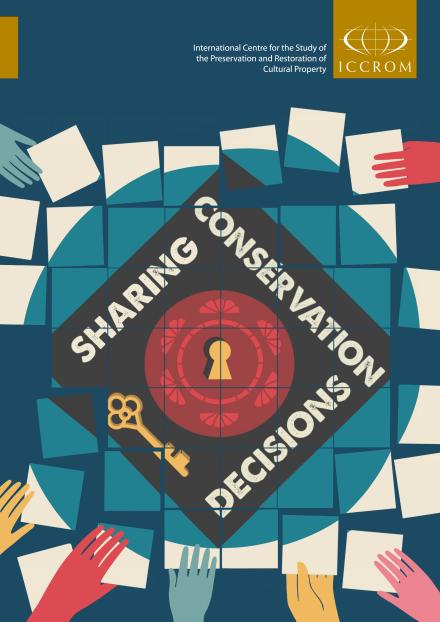Book Review: Sharing Conservation Decisions: Current Issues and Future Strategies
Submitted by sharragrow on

Review by Graham Voce
Sharing Conservation Decisions: Current Issues and Future Strategies
Edited by Alison Heritage & Jennifer Copithorne
International Centre for the Study of the Preservation and Restoration of Cultural Property (ICCROM), Via di San Michele 13, 00153 Rome, Italy, 2018
Free download / e-book: https://www.iccrom.org/news/sharing-conservation-decisions-current-issues-and-future-strategies
276 pages
ISBN 978-92-9077-271-2
This publication brings together a number of years of refreshing and unusual research on heritage conservation addressing a topic that many conservation professionals face on a regular basis; making and sharing decisions regarding their heritage conservation work. Covering a very wide range of conservation topics and areas in which decisions have to be made, the book reflects a very contemporary approach to conservation decision-making, summed up by Stefano DeCaro in his foreword, where he acknowledges the emergence of a community-based approach to conservation decisions, supplanting the previous system of authority-based decision-making. In her foreword, Catherine Antomarchi adds, “an approach founded solely on technical or historical considerations neglects the importance of human factors in determining decisions and their outcomes.”
Sharing Conservation Decisions is comprised of papers presented during a series of discussions and seminars held by ICCROM between 2001 and 2011. In its conclusion, this volume contains a very interesting breakdown of the themes that emerged over the project as a whole regarding decision-making. The topics were, by descending quantity, the balance between heritage values and other competing values; the opening up of decision dialogues with other stakeholders outside the heritage profession; the influences of scientific input; and the importance of sustainability in making decisions. Other themes emerged as well, but these were the most numerous and summarise much of the coverage of discussion and analysis here.
As to the papers themselves there are some fascinating, almost existential, heritage discussions and debates. In particular the paper by Evita Yeung and Chin-Wing Chan entitled “The myth of value: the preservation of street graffiti” is a fascinating review of the decisions that conservators have to make in considering the worth of conserving a particular artefact (and if, indeed, something is an artefact at all). In another fundamental questioning of accepted process, Webber Ndoro notes, “In many ways archaeology disrupts and reconfigures the site or object…” In all of these papers, doubt and questioning are seen to be framing decisions on so much of what a conservator does and how that work is done (if at all). There are many other such questionings and debates in these papers.
Behind this, as editor Alison Heritage notes, is the fact that “the changing uses and expanding range of material goods and formats identified as cultural heritage… mean that we have to redefine our approaches to conservation.” As the range and types of heritage that conservation professionals are asked to work with expand, the awareness of the resources of the profession versus the vastness of the work it is now expected to do are contrasted here too.
The international scope of papers and opinions presented here shows a wide range of opinions across many different world cultures and heritage types and styles, but there is a commonality in approach to addressing conservation decisions and implementing resultant conservation actions across different heritage and cultural arenas. The common threads are the awareness that heritage conservation is of great importance, that conservation decisions have to be made in a different way than heretofore, and also that our shared heritage covers a huge range of human endeavours; and so uncertainty principles have to apply.
For a small profession, heritage conservation has a huge area of responsibility. To achieve its stated ends (over such a huge range of the tangible and the intangible) inevitably involves discussions, decisions and, it would seem, increasing worry and concern. This volume is a valuable and fascinating introduction to, and illustration of, these concerns regarding the ways in which decision-making and implementation can be framed and approached.
AUTHOR BYLINE
Graham Voce is IIC’s Executive Secretary and is responsible for the IIC’s Office team’s day-to-day workings. Since taking on this role in 2004, Graham has been involved with most of IIC’s activities including working with the organisation of (to date) seven IIC Congresses and four Student & Emerging Conservator Conferences, as well as other IIC events, activities and publications. Having studied both Landscape Architecture and English literature to BA (hons) degree level, Graham is a Fellow of the Society of Antiquaries of London and a member of a number of heritage organisations.